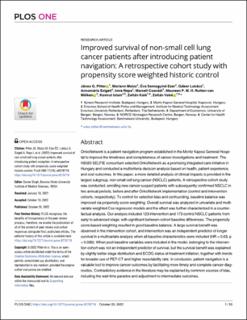| dc.contributor.author | Pitter, Janos | |
| dc.contributor.author | Moizs, Mariann | |
| dc.contributor.author | Ezer, Éva Somogyiné | |
| dc.contributor.author | Lukács, Gábor | |
| dc.contributor.author | Szigeti, Annamária | |
| dc.contributor.author | Repa, Imre | |
| dc.contributor.author | Csanádi, Marcell | |
| dc.contributor.author | Rutten-van Mölken, Maureen P.M.H | |
| dc.contributor.author | Islam, Kamrul | |
| dc.contributor.author | Kaló, Zoltán | |
| dc.contributor.author | Vokó, Zoltán | |
| dc.date.accessioned | 2023-03-03T09:20:01Z | |
| dc.date.available | 2023-03-03T09:20:01Z | |
| dc.date.created | 2022-10-26T21:58:18Z | |
| dc.date.issued | 2022 | |
| dc.identifier.issn | 1932-6203 | |
| dc.identifier.uri | https://hdl.handle.net/11250/3055653 | |
| dc.description.abstract | OnkoNetwork is a patient navigation program established in the Moritz Kaposi General Hospital to improve the timeliness and completeness of cancer investigations and treatment. The H2020 SELFIE consortium selected OnkoNetwork as a promising integrated care initiative in Hungary and conducted a multicriteria decision analysis based on health, patient experience, and cost outcomes. In this paper, a more detailed analysis of clinical impacts is provided in the largest subgroup, non-small cell lung cancer (NSCLC) patients. A retrospective cohort study was conducted, enrolling new cancer suspect patients with subsequently confirmed NSCLC in two annual periods, before and after OnkoNetwork implementation (control and intervention cohorts, respectively). To control for selection bias and confounding, baseline balance was improved via propensity score weighting. Overall survival was analyzed in univariate and multivariate weighted Cox regression models and the effect was further characterized in a counterfactual analysis. Our analysis included 123 intervention and 173 control NSCLC patients from early to advanced stage, with significant between-cohort baseline differences. The propensity score-based weighting resulted in good baseline balance. A large survival benefit was observed in the intervention cohort, and intervention was an independent predictor of longer survival in a multivariate analysis when all baseline characteristics were included (HR = 0.63, p = 0.039). When post-baseline variables were included in the model, belonging to the intervention cohort was not an independent predictor of survival, but the survival benefit was explained by slightly better stage distribution and ECOG status at treatment initiation, together with trends for broader use of PET-CT and higher resectability rate. In conclusion, patient navigation is a valuable tool to improve cancer outcomes by facilitating more timely and complete cancer diagnostics. Contradictory evidence in the literature may be explained by common sources of bias, including the wait-time paradox and adjustment to intermediate outcomes. | en_US |
| dc.language.iso | eng | en_US |
| dc.publisher | Public Library of Science | en_US |
| dc.rights | Navngivelse 4.0 Internasjonal | * |
| dc.rights.uri | http://creativecommons.org/licenses/by/4.0/deed.no | * |
| dc.title | Improved survival of non-small cell lung cancer patients after introducing patient navigation: A retrospective cohort study with propensity score weighted historic control | en_US |
| dc.type | Journal article | en_US |
| dc.type | Peer reviewed | en_US |
| dc.description.version | publishedVersion | en_US |
| dc.rights.holder | Copyright 2022 Pitter et al. | en_US |
| dc.source.articlenumber | e0276719 | en_US |
| cristin.ispublished | true | |
| cristin.fulltext | original | |
| cristin.qualitycode | 1 | |
| dc.identifier.doi | 10.1371/journal.pone.0276719 | |
| dc.identifier.cristin | 2065421 | |
| dc.source.journal | PLOS ONE | en_US |
| dc.relation.project | EC/H2020/634288 | en_US |
| dc.identifier.citation | PLOS ONE. 2022, 17 (10), e0276719. | en_US |
| dc.source.volume | 17 | en_US |
| dc.source.issue | 10 | en_US |

